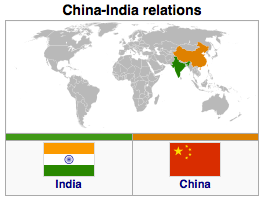China-India Special Representatives Talks: Moving Beyond Boundary Dispute? – Analysis
By RSIS
The 15th round of talks between the Chinese and Indian Special Representatives on the boundary dispute suggests a desire to minimise the role of the dispute in bilateral ties and to move discussions to include regional and global issues.
By Jabin T. Jacob
2012 MARKS a sensitive anniversary in Sino-Indian relations – 50 years of the conflict over their disputed boundary in 1962 that led to a quick and humiliating defeat for India. In half a century, however, relations between the two countries have been radically transformed in several areas – bilateral trade is booming and China and India share concerns over regional and global issues such as the situation in AfPak, energy security, climate change and the reform of international organisations.

And yet, these new interactions and common interests have created their own set of problems such as a mounting Indian trade deficit, or the competition for energy resources. Meanwhile, the persistence of their boundary dispute further ensures that relations remain beset by mistrust and a sense of rivalry.
Changing Attitudes
Against this background of both expanding engagement as well as growing suspicions at the regional and global levels, the 15th round of Sino-Indian Special Representatives (SR)-level talks held in New Delhi in mid-January this year, was the latest in a process of bilateral boundary negotiations over three decades. This round of talks was especially noteworthy given that they had been postponed over the issue of the Dalai Lama addressing a Buddhist conclave in New Delhi about the same time as the SR talks had been scheduled in November 2011. Later, in early January, the Chinese denied a visa to an Indian Air Force officer from Arunachal Pradesh who was part of an official Indian military delegation to China.
Such situations would have previously resulted in prolonged acrimony between the two sides. But in a sign of growing maturity in bilateral ties, the fourth Sino-Indian Annual Defence Dialogue took place as scheduled in New Delhi in early December. The SR talks too, were rescheduled without further ado with the two SRs also speaking at each other’s embassies to set a positive tone for the talks.
What explains this willingness on both sides to stick with the talks despite the various problems or provocations? For India, the ruling UPA government clearly cannot afford any foreign policy fiascos on top of severe domestic challenges to its legitimacy. China, meanwhile, has its own reasons, including problems with its neighbours elsewhere, such as on the South China Sea issue; the so-called ‘return’ of the US to the Asia-Pacific; and its upcoming leadership transition.
China and India also perhaps realise they can ill-afford mutual hostility at a time of global economic uncertainty. Instability in the AfPak region too, will require at least some degree of coordination between the two sides, especially post-2014. Thus, the global and regional contexts are possibly pushing China and India towards cooperation given that neither side at present possesses the ability to make decisive moves by itself.
New Boundary Mechanism
The boundary talks are now officially in the second stage of a three-step process involving agreement on principles, a framework and finally, a boundary line. The latest SR talks resulted in a new Working Mechanism for Consultation and Coordination on India-China Border Affairs intended to ensure real-time contact between the two foreign ministries in case of an intrusion across the Line of Actual Control (LAC) by either side. According to a recent Indian media report, over 500 Chinese intrusions were recorded in the last two years in all three sectors of the disputed boundary with over 300 in 2011 alone. Given that the two sides disagree on even where the LAC lies, such incursions are not surprising and can be expected to continue.
Doubts have been raised by Indian analysts about how soon officials sitting in the two capitals will be able to react to a developing situation on the LAC, and whether the new mechanism constitutes simply another layer of bureaucracy. However, the new system could also be interpreted as a necessary move owing to the leadership transition on the Chinese side slated for late 2012. Dai Bingguo, the Chinese SR since the inception of the talks in 2003, will make way for someone new. In the event, the next SR-level talks are unlikely to be held for well over a year from now, and with LAC incursions showing an upward trend, the new mechanism, is perhaps, a necessary one.
One Step Back, Two Steps Forward?
There is a further interpretation possible. Could the new mechanism possibly be a signal that the SR-level talks on the boundary resolution have reached a dead end? Despite declarations that the SR-level talks on the boundary will continue, it could well be that it is the new border mechanism that will deal with the actual nitty-gritty of the boundary dispute that arises from the current status quo.
Meanwhile, China and India could use the SR-level talks to ensure greater coordination between them in addressing issues of global concern – an important political goal for both sides. Indeed, official statements have admitted that the SRs already discuss a range of issues besides the boundary dispute.
During the two-day talks, the two sides also agreed to prepare a joint record on the progress made so far on the boundary issue. Beijing and New Delhi should ensure that any such record is also available in the public domain. This would be a significant step indicating that the two countries realise the importance of preparing their respective populations for the inevitable compromises any resolution of the boundary dispute will entail – including possible territorial concessions.
Jabin T. Jacob is Assistant Director, Institute of Chinese Studies (ICS), Delhi, India and Assistant Editor of the journal, China Report. He is presently a Visiting Research Fellow in the South Asia Programme at the S. Rajaratnam School of International Studies (RSIS), Nanyang Technological University.
